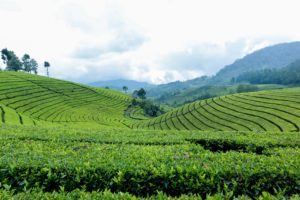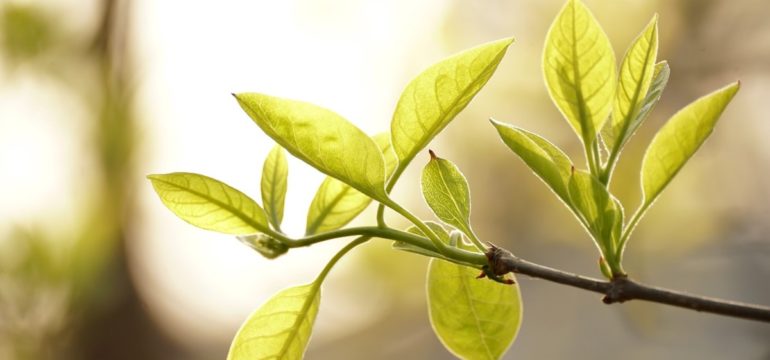By Ming Yin Kwong
When I ask you to imagine a tea field, what comes to your mind? For me, it has lush and green shrubs enveloped in morning cool mist, sitting against a green mountain side like a picture-perfect landscape. However, not all tea plants are green, despite what we usually associate them with. Some special cultivars of tea, generally called albino tea, take on a paler and more yellow/white appearance. They usually have delicate taste and are made into white or green tea.

Photo by Yosi Azwan from Pexels
There are two types of albino tea: the photosensitive type and the thermosensitive type. For the photosensitive type, the tea leaves are pale when they receive plenty of sunlight, but they revert to green when they are shaded. Wang et al. conducted a study, where they placed a piece of white paper on albino tea leaves (Wang et al. 2016). The area that received full sunlight remained pale yellow, while the area shaded under the white paper was green. There were less normal chloroplasts in the yellow leaf area under direct sunlight. Since chloroplasts are the organelles that contain the green pigment chlorophyll, less chloroplasts means a lighter colored leaf.
For the thermosensitive type, the tea plants only remain pale when the climate is cold. When the temperature rises, the tea leaves convert back to the green color that we are used to. A study by Du et al. compared two cultivars of tea plants: an albino cultivar “Xiaoxueya” and a normal green tea cultivar “Fudingdabai” in different temperatures (Du et al. 2010). The researchers found that the albino tea plants remained white at 15°C and reverted to green at 20°C or above. The green tea cultivar stayed green regardless of temperature. The number of chloroplasts decreased as temperature decreased in the albino tea leaves. The decrease in chloroplasts, and thus chlorophyll, caused the tea plants to become pale.

Photo by Jakub Kapusnak on Foodiesfeed
Albino tea tend to have a delicate taste due to its higher concentration of amino acids, which contributes to the umami and sweetness of the brew (Feng et al. 2014; Du et al. 2015). The most abundant amino acid in tea, L-theanine, is more than doubled in concentration in the albino mutant when compared to its green original cultivar (Cheng et al. 2019). Since L-theanine has neuroprotective and calming effects (you can read more on my previous “tea drunk” article), this might be a desirable trait of albino tea.
Albino leaves are also known to have less catechins and caffeine when compared to traditional green tea leaves (Feng et al. 2014; Du et al. 2015). Although the lower caffeine content might be bad news for some, the lower caffeine and catechins content also means less bitterness and astringency. The unique taste and rarity make albino tea a highly sought-after commodity in the tea community. However, despite its excellent taste, it is worth noting that the albino cultivars could have a less fragrant aroma. A study by Dong et al. found that the total aroma compounds and their precursors are less abundant in the yellow mutant when compared to the original green cultivar (Dong et al. 2018). Especially, (Z)-3-hexenol, a grassy smelling chemical, and linalool, a floral scented compound, are significantly less in the albino cultivar.
After reading the description of albino tea, what are your thoughts? Would you be interested in trying it yourself? Or perhaps you already have tried it before? Please let us know and share your experience on albino tea. Cheers!
References
Du Y, Chen H, Zhong W, et al (2010) Effect of temperature on accumulation of chlorophylls and leaf ultrastructure of low temperature induced albino tea plant. African Journal of Biotechnology 7:1881–1885. https://doi.org/10.4314/ajb.v7i12.58832
Du YY, Liang YR, Wang H, et al (2015) A study on the chemical composition of albino tea cultivars. http://dx.doi.org/101080/14620316200611512142 81:809–812. https://doi.org/10.1080/14620316.2006.11512142
Dong F, Zeng L, Yu Z, et al (2018) Differential Accumulation of Aroma Compounds in Normal Green and Albino-Induced Yellow Tea ( Camellia sinensis) Leaves. Molecules (Basel, Switzerland) 23:. https://doi.org/10.3390/MOLECULES23102677
Feng L, Gao MJ, Hou RY, et al (2014) Determination of quality constituents in the young leaves of albino tea cultivars. Food Chemistry 155:98–104. https://doi.org/10.1016/J.FOODCHEM.2014.01.044
Cheng S, Fu X, Liao Y, et al (2019) Differential accumulation of specialized metabolite l-theanine in green and albino-induced yellow tea (Camellia sinensis) leaves. Food chemistry 276:93–100. https://doi.org/10.1016/J.FOODCHEM.2018.10.010
Wang K, Li N, Du Y, Liang Y (2016) Effect of sunlight shielding on leaf structure and amino acids concentration of light sensitive albino tea plant. African Journal of Biotechnology 12:5486–5495. https://doi.org/10.4314/ajb.v12i36.

Ming Yin Kwong | Linkedin
SMF Blog Writer
Ming graduated with her B.S. in Chemistry at University of California, Davis. Internship opportunities with Mi Rancho and UC Davis Olive Center made her realized her passion for Food Science. She decided to stay at UC Davis for her Ph.D. in Food Science, with a research focus on tea chemistry. When she is not crushing tea leaves or developing HPLC methods in the laboratory, Ming enjoys working out to balance the extra calories that she consumes, traveling with friends and family, watching cooking shows, and playing video games.






Leave a Reply